Yngwie Malmsteen has an unmistakable style and tone. When you hear him rip his way through his diminished arpeggios and Harmonic Minor scale runs, you know it’s him.
In this guide, I’ll go through Yngwie’s guitar rig and explain each part and how it contributes to his tone.
By the end of this guide, you’ll have a better idea of how you can replicate his guitar tone.
If you ask in a forum or on social media how to get a Yngwie Malmsteen guitar tone, you will receive responses such as:
- Tone is all in the fingers!
- The only way you’re gonna get that Yngwie tone is to have Yngwie come and play through your amp
- Just play the Harmonic Minor scale
- Sweep pick a lot of diminished arpeggios
While there is some truth in these replies, these aren’t helpful answers. Not helpful at all.
Yes, tone starts at the fingers and what you play is far more important than the gear you play it on. But gear does play an important role and should also be considered. This guide’s goal is to explain the gear and effects to get you closer to Yngwie’s tone.
Of course, you’re not going to magically sound like Yngwie by buying the same gear he uses. Think of this guide as a starting point to get you a bit closer.
After you read this guide, spend some time learning how to play his songs and the techniques he uses. But make no mistake – gear plays a crucial role in his tone.
Yngwie Malmsteen’s Guitars
While most guitarists use a range of different guitars, Yngwie has a clear choice. He was inspired after seeing Hendrix playing a Stratocaster and has been playing them ever since.
Yngwie Malmsteen plays a signature YJM Fender Stratocaster. His guitar uses a scalloped fretboard as well as his signature YJM Seymour Duncan pickups.

His guitar is a core component to his tone and there are a few important features you’ll notice compared to a typical Stratocaster.
Here are some key features in his signature guitar:
- 21 Super-Jumbo frets
- Scalloped Fretboard
- Signature YJM pickups
- Three-way pickup selector
- Brass nut
- Maple fretboard (he does own guitars with rosewood fretboards as well)
Unfortunately, there’s one important piece of hardware missing from his signature guitar that is found on all of his actual guitars. Fortunately, this is an easy fix with one of these.
I’ll explain the scalloped fretboard and his pickups in detail to give you a better idea of why they matter.
Scalloped Fretboard
The first thing anybody who picks up his signature guitar will notice is the scalloped fretboard.
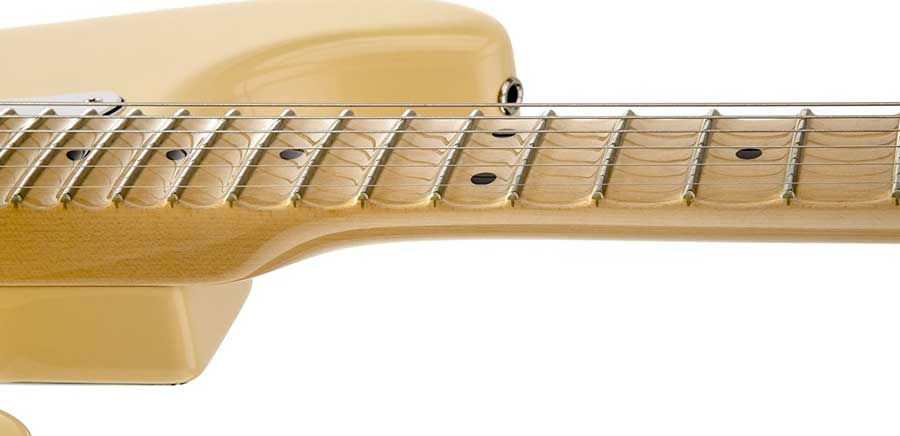
A scalloped fretboard is when the wood between the frets have been carved away. Some guitars only scallop some of the frets (eg: Steve Vai‘s Ibanez JEM scallops the upper frets), while Yngwie’s guitar has the entire fretboard scalloped.
Yngwie first scalloped his fretboard after being inspired by a 17th-century lute. He kept the scalloped fretboard after noticing how great they felt to play.
The only time I’ve seen Yngwie’s signature guitar was in a guitar shop in Tokyo. Of course, I had to try it out.
Playing a guitar with a scalloped fretboard feels completely different from a typical guitar fretboard.
When you place your finger down on the string, you don’t feel the fretboard at all.
This means when you play a bend or vibrato, the wood of the fretboard isn’t rubbing against your fingers. Your fingers feel like they’re floating on the strings.
It took about 30 seconds to get used to it, then it felt surprisingly comfortable. I know some people don’t like the feel of a scalloped fretboard, but I found it ridiculously fun to play.
Bends and vibrato felt amazing to play as you were completely free to push and pull the string around without any friction from the fretboard.
While the scalloped fretboard doesn’t play a big role in Yngwie’s tone (removing some wood will likely impact tone to a minimal amount), it does play a big role in feel.
Yngwie uses a wide vibrato, which is easy to do on the scalloped fretboard. You can play wide vibrato on a regular fretboard, but as I found out after trying out his guitar, it doesn’t feel anywhere near the same.

Some people feel the scalloped fretboard allows you to play faster, but you can certainly play any of his solos on a regular fretboard just as easily.
Signature Pickups
As I’ll explain later, Yngwie uses a lot of gain (he used less in the past). This can be a problem with single-coil pickups as they can produce a lot of noise.
There are ways he deals with this noise as I’ll explain later, but one way is with his signature pickups.
Yngwie Malmsteen uses Seymour Duncan S10 Fury Stack single-coil pickups. These pickups are hum-canceling pickups in a single-coil pickup size.
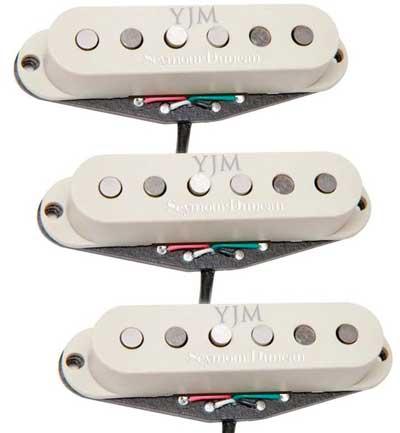
While you can produce a perfectly fine Yngwie tone with a typical set of single-coils, these are voiced differently and produce less noise.
Find out more about his signature pickups here.
Yngwie also lowers the height of his middle pickup as you can see in this photo:
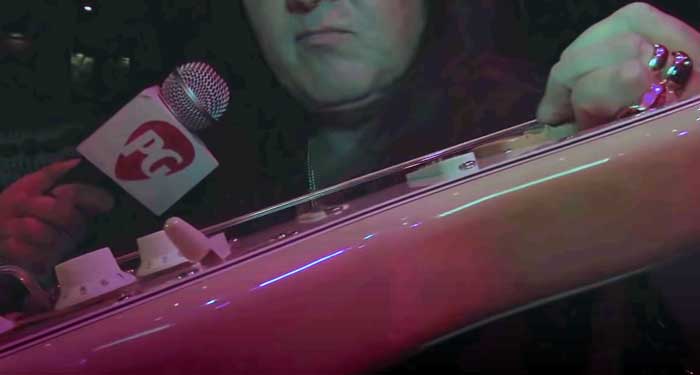
This means the neck and bridge pickups produce a high output signal while the middle pickup will be significantly quieter.
In the past, he mainly used DiMarzio signature pickups as well as a set of Fender Noiseless Pickups. These noiseless pickups are a good lower-priced alternative to his signature pickups.
Yngwie Malmsteen’s Acoustic Guitar
While Yngwie is mostly known for his electric guitar playing, he does occasionally play nylon-string acoustic guitar.
In fact, he released an entire acoustic album in 2009, Angels of Love.
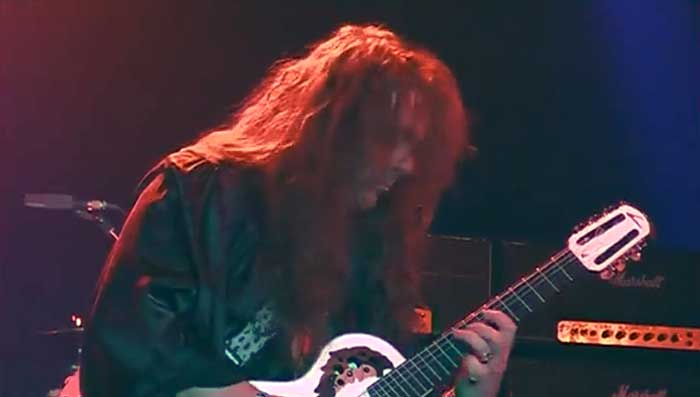
Yngwie has used a variety of acoustic guitars over the years. Most of them have been Ovation acoustics due to the fact that he can easily mount them on a stand on stage and they don’t produce any feedback.
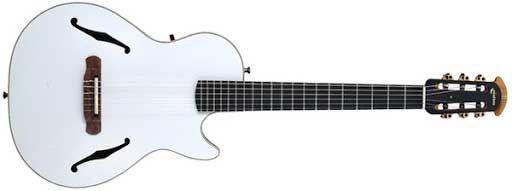
Yngwie does have two signature acoustic models, the steel-string Ovation Viper YM68 and the more popular nylon-string Ovation Viper YM63.
If you do want to get an acoustic guitar to play some of Yngwie’s acoustic songs, I suggest getting any nylon string guitar.
Ovation guitars are great, but the reason he uses them (easy on stage) may not be important to you.
The key point is to find a nylon-string guitar that feels comfortable, has low action, and good upper fret access.
Yngwie Malmsteen’s Guitar Strings
Yngwie Malmsteen tunes his guitars a half-step down to Eb (Eb Ab Db Gb Bb Eb). This tuning is popular with many Strat players including Jimi Hendrix and Stevie Ray Vaughan.
Yngwie prefers a set of strings that are light on the high strings and heavy on the lower strings.
He used to use Fender 3250R Super Bullets, which are: .008 .011 .014 .026 .036 .048 from high E to low E.
He now uses his own signature Yngwie Malmsteen Fender Bullet strings, which are: .008 .011 .014 .022 .032 .046. You can see that the higher strings are the same, while the lower strings are slightly lighter.

I suggest trying his set of strings out purely to see what it’s like playing with light gauges on the higher strings and heavier gauges on the lower strings.
The lighter gauge strings and the lower tuning creates low tension on the strings, which makes bends and vibrato feel effortless.
Find out more about string gauges, metals, and string tension in this guide.
Yngwie Malmsteen’s Amps
If you were to reduce Yngwie’s guitar rig down to two items, it would be a Fender Stratocaster and a Marshall amp (you can tell he was inspired by Hendrix).
Anybody who has seen Yngwie live will know about his wall of Marshalls.

As Yngwie says, “there are only two man-made objects you can see from outer space. One is the wall of China, one is the Yngwie Malmsteen wall of Marshalls”.
Who cares if only two of them are actually plugged in, it’s an impressive sight.
The amp heads he uses are his signature Marshall Yngwie Malmsteen YJM100 head combined with 4×12 Marshall cabinets with 75w Celestions.
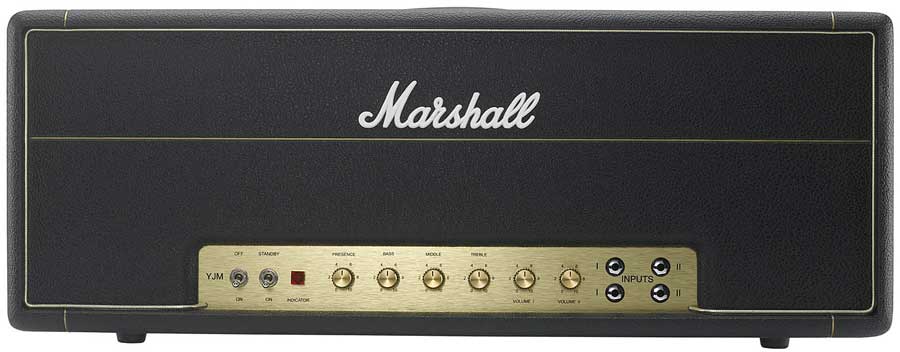
The above photo may look like a typical vintage-style Marshall head, but it actually packs quite a few modern features in.
The front of the head is designed to look like a vintage amp with basic tone controls, but the back of the amp gives you access to features such as:
- The ability to switch between 50w and 100w
- Noise gate and boost
- Digital reverb
- FX Loop
- Attenuator control
For a guitarist playing at home, the attenuator control allows you to keep the sound of a cranked tube amp at any volume level.
This means you can crank the amp, then dial the output power down all the way down to 0.05w to play at a comfortable volume level.

It may be hard to get your hands on one of these head units today.
If you do want to try and get a Yngwie tone, the key point is to get yourself a Marshall tube amp.
If the amp you buy doesn’t include an inbuilt boost, noise gate, or reverb, you can easily add those features to your guitar rig using pedals (covered next).
The point to keep in mind is that a saturated Marshall tube amp is a core component of Yngwie’s tone.
Yngwie Malmsteen’s Pedals
While you can get a great sounding Yngwie tone using only a guitar and amp, there are a few pedals that play an important role in shaping his tone.
Here is his pedalboard taken from somebody in 2019:
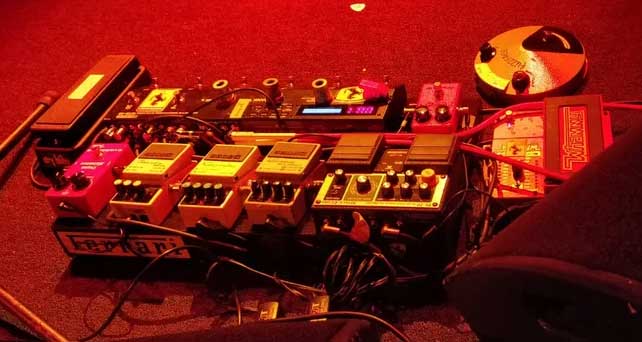
I’ll go through all of the parts of this pedalboard so you can decide which pedals you might like to get for yourself and which aren’t as important to you.
Here’s another photo from his pedalboard in 2017:
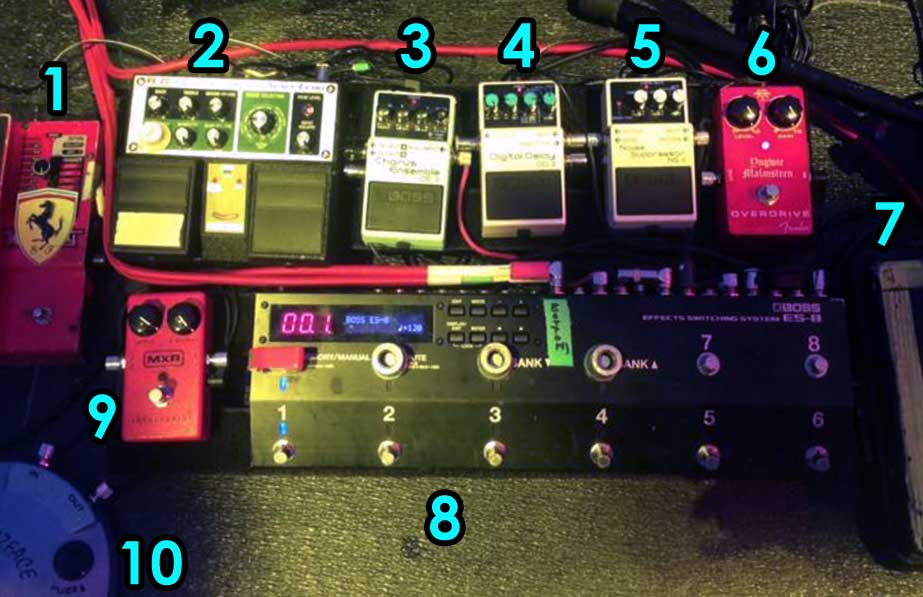
As you can see, his pedalboard hasn’t changed over the last few years, so I’ll explain everything in detail as numbered above.
DigiTech Whammy (1)
The DigiTech Whammy is a fantastic pedal that allows you to experiment with pitch shifting and harmony ideas.
Honestly, out of all of the pedals covered in this guide, the Whammy is probably the least important to get you a Yngwie tone.
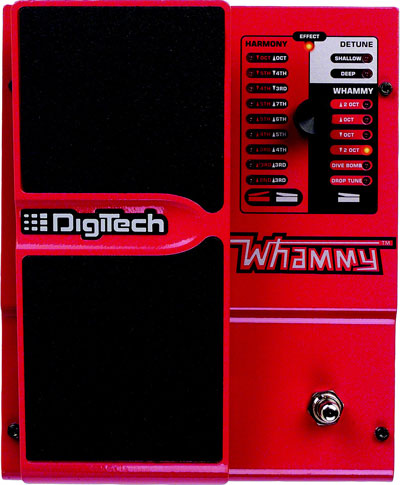
Read my review of the DigiTech Whammy DT to learn about the different features. Yngwie doesn’t use the Whammy DT (he uses the Whammy 5), my review explains the difference between the models.
If you’re interested in using a Whammy pedal, check out these Whammy songs to give you an idea of the type of things you can do with one (includes Guitar TAB).
BOSS Roland RE-20 Space Echo (2)
The RE-20 Space Echo is a simulation of the iconic 70s Roland RE-201, which was an analog tape-based delay and reverb.
To call the Space Echo a combination of delay and reverb doesn’t do the pedal justice.
It can produce some typical delay and reverb effects, but you can take things much further into ambient and extreme effects.

While Yngwie’s amp does have inbuilt reverb, I imagine he also uses his RE-20 to produce his reverb.
If you’re interested in ambient and lush reverb effects, the RE-20 is worth looking into.
If you’re just looking for a simple reverb effect to match what Yngwie uses, I suggest finding a simple reverb pedal from this guide.
The Space Echo is a beast of a pedal and complete overkill if you just want to add some reverb to your tone.
Find out more about the BOSS RE-20 Space Echo here.
BOSS CE-5 Chorus Ensemble (3)
Yngwie uses the BOSS CE-5 for his clean guitar tone, but he says he also has it on one of his settings to use with his drive tone. It’s one of the most popular chorus pedals of all time, so a solid pedal to choose.
I personally love how a chorus pedal can give your clean some extra character or energy, so if you’re used to playing dry clean tones, you might want to look into chorus.
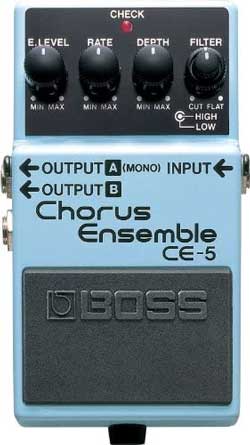
The settings on his chorus pedal seem to be different in every photo I’ve seen, so it’s something you’ll need to experiment with if you do get a CE-5.
Find out more about chorus and the best chorus pedals in this guide (includes a detailed look at the BOSS CE-5).
BOSS DD-3 Digital Delay (4)
While the Space Echo pedal can produce delay effects, the BOSS DD-3 does a far better job at producing clean and clear delay effects.
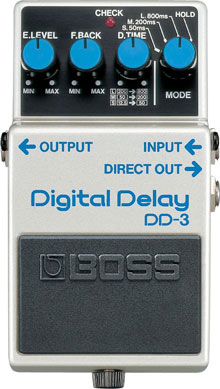
In all of the photos and videos I’ve seen of his DD-3 up close, the effects level knob has been cranked up to max.
This suggests that Yngwie only uses this delay for extreme delay effects instead of having a subtle background delay.
It’s likely he uses his Space Echo pedal for most delay/reverb effects, then uses the DD-3 for times when he wants more extreme delay.
Learn more about delay and the best delay pedals in this guide.
BOSS NS-2 Noise Suppressor (5)
The BOSS NS-2 is a key part of Yngwie’s guitar rig and helps prevent the copious amount of noise from his cranked amps and drive pedal.
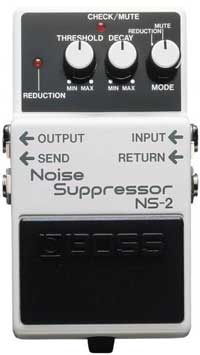
Where I could see the settings in photos or in videos, Yngwie sets the threshold almost all the way up, delay to about 8 o’clock, and the mode is set to reduction.
In a couple of interviews, he demonstrates what happens when the pedal is turned off. There was a huge wash of hum and noise. The NS-2 does an amazing job of dealing with this without destroying your tone.
I talk about the important differences between noise suppressors and noise gates in my Guitar Effects Course. If you’re interested in how these pedals can be used to control your tone, check the course out.
Fender Yngwie Malmsteen Overdrive (6)
The Fender Yngwie Malmsteen overdrive pedal is a clone of the DOD JYM-308, which is a modified version of the DOD 250.
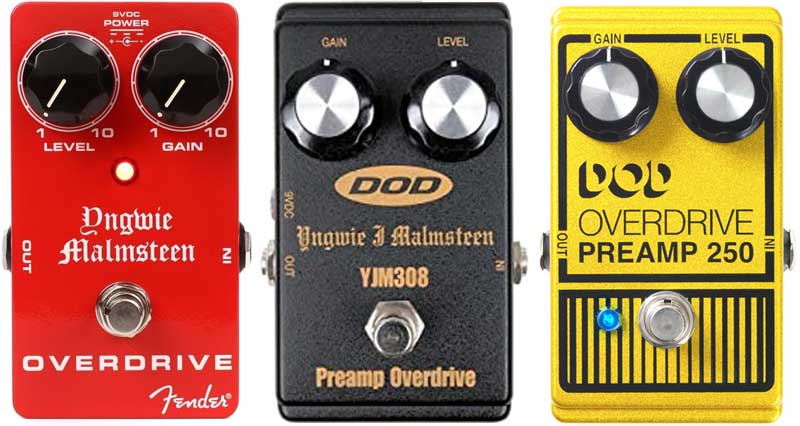
Yngwie has used all three of the above overdrive pedals over the years, so if you can find any of them second hand, they’ll do the job.
Alternatively, if you want to get into pedal building (I’m working on a series of guides and tutorials), you can find the schematics to build your own DOD YJM308, which is a very simple build.
In every photo I’ve seen of the red Fender pedal on his rig, the gain knob is always cranked to 10. I’ve only seen the volume knob turned down slightly below 10 in a video from his home studio.
Normally, cranking an overdrive pedal all the way results in a horrible mess, but it seems to work for Yngwie.
If you’re interested in the difference between overdrive, distortion, fuzz, and boosters, check out my Guitar Effects Course. It explains and demonstrates all of these options, along with all other effects in detail.
Dunlop Cry Baby Wah (7)
What pedalboard would be complete without a wah pedal? As Yngwie was heavily inspired by Jimi Hendrix, it should be no surprise that he has a Dunlop Cry Baby Wah on his pedalboard.
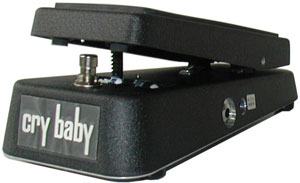
Read my review of the original Cry Baby wah here to learn more about it.
If you want to see other options for wah pedals, check out my Ultimate Guide on Wah Pedals.
BOSS ES-8 Effects Switching System (8)
The BOSS ES-8 is an important piece of hardware that helps Yngwie avoid tap dancing when changing sounds.

The basic idea is that you plug all of your individual pedals directly into the ES-8. Then you can set up different patches to enable or disable any pedal combination you want.
You can change the order of your pedals, enable multiple effects at once, or create unique patches for individual songs.
I highly recommend the ES-8 or the smaller ES-5 to anybody with more than about 5 pedals on their pedalboard.
Find out more about the BOSS ES-8 in this gear spotlight. I explain how the pedal works and why you might want to get one.
MXR M102 Dyna Comp (9)
The MXR Dyna Comp is a simple and iconic compressor pedal used by countless guitarists.
Yngwie says in an interview that he has one patch set up to send the compressed guitar straight to his amp, then in another patch, he splits the compressed signal with other pedals.
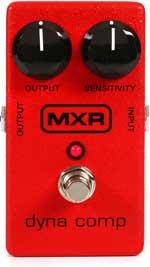
The key point to remember with compressors is that they’re tools you can use to shape your tone. So it makes sense for Yngwie to use it in different patches for different purposes.
Learn all about compressors, best options, and details of the Dyna Comp in this guide.
Dunlop Fuzz Face (10)
This is a bit of a hard one to explain. There’s clearly a Fuzz Face pedal in many photos and videos of Yngwie’s pedalboard, but as you can see in the below photo, the Fuzz Face isn’t even plugged in!

In some interviews, Yngwie flat out says he doesn’t use the Fuzz Face and says he just likes it on stage because it looks like a landmine. In another interview, he says he does use it and you could see it was plugged in.
As always with Yngwie, it’s hard to tell if he’s just trolling (he does that a lot) or if he’s being serious.
He says that his switching system uses the Fuzz Face on some settings, so who knows whether he actually uses it or not. I really don’t know if he’s being serious or not! My guess is he only uses it if he’s doing something like covering a Hendrix song.
Powering His Pedals
If you were to build a pedalboard based off of Yngwie’s pedals, you need to consider how you power everything.
With 10 different pedals, it can get messy really quickly.
What I found surprising with Yngwie’s pedalboard is that he daisy chains his pedals together (find out about daisy-chaining here).
Daisy-chaining is when you connect a series of pedals together using one cable as shown below:
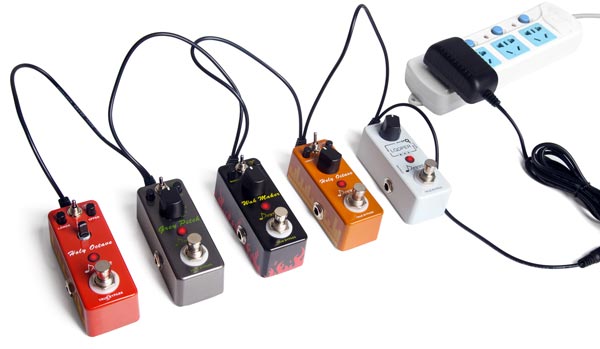
Some guitarists avoid daisy-chaining their guitar pedals because they’re worried about noise creeping into their tone. It should be clear from what I’ve talked about above that Yngwie isn’t worried about anything like that.
Read this guide to learn more about powering guitar pedals. The guide covers all of the options so you can work out what is best for you.
What I Like About Yngwie’s Guitar Rig
When you look at some famous guitar rigs, they can feel overwhelming. Many famous guitarists will use ridiculously expensive rack effects units connected to a complex MIDI switching system. If they do use any pedals, they’re usually expensive boutique pedals.
My eyes often glaze over when looking at famous rigs because they’re often ridiculously complex and expensive.
What I like about Yngwie’s guitar rig is that he uses big brand name pedals, a standard effects switching system, and a cheap power supply. These are all things anybody can buy (except for the pedals that are now discontinued).
Yes, his signature guitar and amp are expensive, but you can get pretty much the same results with almost any Strat and Marshall.
It’s refreshing to see a pedalboard using standard BOSS pedals and a few other typical pedals that any average guitarist may already own.
Yngwie’s rig shows that you don’t need to spend thousands to shape a tone you love. While some guitarists may turn their noses up at some of his choices or the fact that he daisy chains his pedals, he’s happy with it.
This is a great lesson for you and me – find the pedals and gear that you love and don’t worry about what the price tag was. If you find a $50 pedal that you love, use it. Don’t worry because everybody else is using a $400 boutique pedal that does the same basic thing.
How to Sound Like Yngwie Malmsteen
All of the above gear plays a massive role in helping Yngwie get his tone. If you were to buy a few of the above pedals along with a Strat and a Marshall, you’ll be surprised how close you can get to his guitar tone.
Of course, the gear you play on is only part of the picture. What you play obviously matters.
While there are plenty of lessons online on how to play like Yngwie (he has produced some incredible instructional videos over the years), here are some basic tips on what to work on to sound more like him.
Search online for ‘Yngwie Malmsteen Instructional Video’ to find lessons he has produced over the years. As a teenager, I spent countless hours working on the exercises and licks he shared in old VHS lessons. You can still find these videos online if you know where to look.
Listen to How Yngwie Uses His Gear
If you buy any pedals covered above, listen to his music and try to identify times when he uses that effect.
Watch live footage of him playing and listen for any changes to his tone.
When you do identify an effect in his tone, try to replicate what you hear using your ears. Don’t rely on presets people share online, learn to get the sounds you want from your gear by experimenting.
Use Your Guitar’s Volume Knob
Yngwie uses a lot of gain. He pushes his amps to saturate his tone and he uses his overdrive pedal to add more gain.
But what you will notice if you watch him play is that he will use his volume knob to back off the gain when he wants.
When he wants a slightly cleaner guitar tone, he won’t turn off the overdrive pedal. Instead, he’ll turn his volume knob on his guitar down slightly.
Practice using your volume knob to match the type of tone you want for anything you play. Back the volume off to clean up your tone and turn it back up for some heavy saturation.
Violining With Delay
‘Violining’ is a technique where you combine the use of a delay pedal with volume knob swells.
The basic idea is that you pick a note while your guitar’s volume knob is set to zero, then quickly roll the knob with your pinky to full. Then immediately roll it back down to zero, then pick another note.
If you repeat this fast enough and combine it with a delay pedal, it starts to sound like a violin.
Here’s Yngwie demonstrating the technique with stereo delay:
There are two important aspects to getting this technique to sound good:
- Practice your volume swells until you can effortlessly apply it to any note quickly
- Set up your delay pedal to repeat each note once or twice at a speed so it doubles up with the next note
This is a lot of fun to play, so spend some time trying it out.
Know Your Natural and Harmonic Minor Scales
Yngwie has a distinctive sound when he plays and part of that is thanks to his use of scales and arpeggios.
Spend some time learning and using the Natural Minor scale as well as the Harmonic Minor scale.
He does use other scales and modes, but the Harmonic scale is a great starting point to understanding his approach to music.
Ripping into a Harmonic minor scale run with your guitar and amp set up right will sound and feel just like Yngwie.
3 Notes Per String
Yngwie likes to play scale runs using either 3 or 6 notes per string. Of course, he does other things but practicing this technique is a good starting point.
Learn to feel comfortable freely moving up and down the fretboard using legato as well as picking every note.
When you watch videos of Yngwie play, pay close attention to his picking hand. Notice how economical and effortless he is with his hand.
Sweep Picking
If you want to sound like Yngwie, you’ll need to master sweep picking.
Start out with sweeps over 3 strings, then gradually work your way to larger sweeps.
Memorize all the different arpeggio shapes and practice combining them. You can start by studying his use of arpeggios in his music, but I suggest also experimenting and trying to come up with your own solos based on his style.
Learning to improvise and combine arpeggio shapes in new ways teaches you far more than only repeating things Yngwie has played in his songs.
Yngwie Malmsteen’s Amp Settings
If you want to try and copy Yngwie’s lead guitar tone, you’re probably looking for his amp settings.
Well, if you were to ask him, he would no doubt say “everything turned up”.
If you want to really find out what Yngwie Malmsteen’s amp settings are, read through this guide. The guide won’t give you the answer you want, but it’ll give you the answer you need.
I highly recommend reading the above guide. You might think you’ll be better off if somebody gives you exact amp settings to copy, but as the guide explains, you won’t be better off. Learning how to dial in the right tone will give you far better results than following some presets somebody on the Internet suggested.
More Guitar Rigs Explained
Understanding a guitarist’s rig helps you get a better understanding of how that guitarist thinks about music.
Here are a couple of interesting guitar rigs you might want to check out next:
Check out more guitar rig guides here and pick out a few guitarists you’re interested in to learn about their tone and effects.
